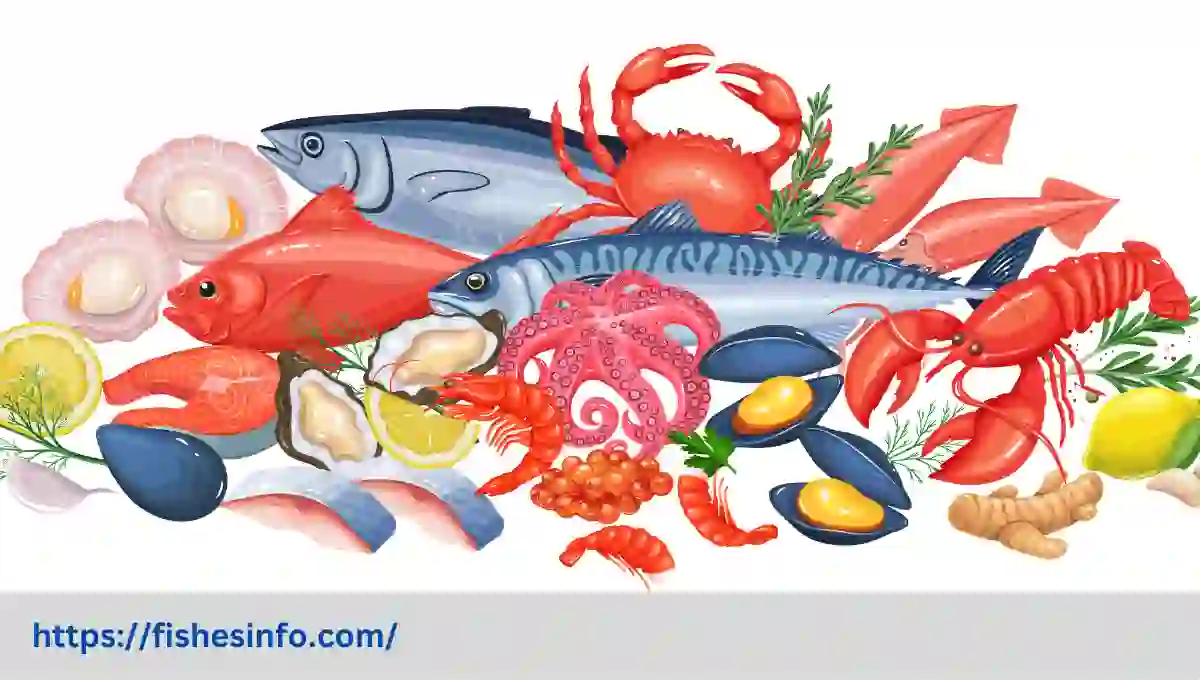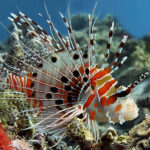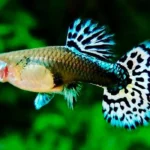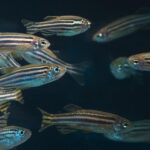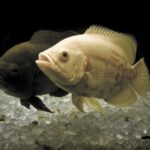Because it tastes great and is good for you, seafood has long been a mainstay in meals all over the world. From the deepest parts of the ocean to rivers and lakes with fresh water, seafood includes a wide range of watery animals that people worldwide enjoy eating. Seafood has a lot of different textures and tastes, so there is something for everyone. Whitefish has a delicate flavor, shrimp has sweet meat, and salmon has a rich umami flavor.
Seafood is tasty and full of good things for you like protein, omega-3 fatty acids, vitamins, and minerals. This makes it a good choice for a healthy, balanced diet. No matter how much you love seafood or how new you are to it, the world of seafood has a lot of new tastes and experiences waiting to be found.
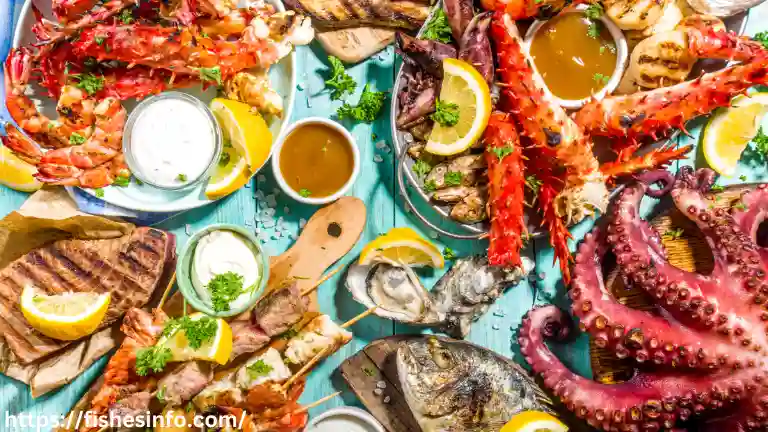
What is Seafood?
Any animal or plant that people eat from the sea is called seafood. Clams, mussels, oysters, and fish and shellfish like shrimp, crab, and lobster are all in this group. Because it has protein, omega-3 fatty acids, vitamins, and minerals, seafood is a healthy food that should be a part of a balanced diet.
Some ways to cook and eat it are raw (sushi and sashimi), cooked, grilled, fried, or steamed. It is an important part of many dishes around the world.
What are the different types of Seafood?
Seafood includes a lot of different kinds of watery animals that people eat.
Here are some of the main types of seafood:
Fish
Fish are perhaps the most common type of fish and come in a wide range of species. Popular types include salmon, tuna, cod, haddock, tilapia, and trout. Fish are rich in protein, omega-3 fatty acids, and different vitamins and minerals.
Some Popluar Fish Types Used as Seafood
Here is a list of various types of fish commonly used as seafood:
- Anchovies
- Barramundi
- Bass
- Carp
- Catfish
- Cod
- Eel
- Flounder
- Grouper
- Haddock
- Halibut
- Herring
- Mahi Mahi
- Mackerel
- Perch
- Pollock
- Salmon
- Sardines
- Snapper
- Sole
- Swordfish
- Tilapia
- Trout
- Tuna
- Whitefish
- Yellowtail
This list includes a variety of fish species commonly enjoyed as seafood around the world.
Shellfish
Shellfish include crabs and mollusks. Crustaceans are animals with hard exoskeletons, such as shrimp, crab, lobster, and crabs. Mollusks are soft-bodied animals with shells, including clams, mussels, oysters, scallops, and squid. Shellfish are a good source of energy, vitamins, and minerals.
List of Popular Shellfish Seafood
Here is a list of popular shellfish used as seafood:
- Clams
- Crab
- Crawfish
- Lobster
- Mussels
- Oysters
- Scallops
- Shrimp
These shellfish are widely enjoyed for their unique tastes and textures, and they are used in a variety of meals around the world.
Cephalopods
Cephalopods are a type of mollusk marked by limbs, including squid, octopus, and cuttlefish. These creatures are high in protein and low in fat, making them a healthy fish pick.
Popular Cephalopods used as Food
Here is a list of famous cephalopods used as seafood:
- Squid
- Octopus
- Cuttlefish
- Nautilus
These cephalopods are known for their soft feel and are used in a variety of meals in many cuisines around the world.
Crustaceans
Crustaceans are a type of animal and include shrimp, crab, lobster, and crayfish. They are full of protein, vitamins (such as B12), as well as minerals (like zinc and selenium).

Famous Crustaceans used as Food
Here is a list of popular crustaceans used as seafood:
- Shrimp
- Crab
- Lobster
- Crawfish
- Prawns
- Krill
- Crayfish
- Barnacles
These crustaceans are widely enjoyed for their sweet and savory flavors. These are also used in a variety of dishes in cuisines around the world.
Mollusks
Mollusks are soft-bodied animals with shells and include clams, mussels, oysters, scallops, and snails. They are an excellent source of protein, fatty acids known as omega-3, vitamins, and minerals.
List of Famous Mollusks Used as Seafood
Here is a list of popular mollusks used as seafood:
- Clams
- Oysters
- Mussels
- Scallops
- Squid
- Octopus
- Abalone
- Conch
- Snails (escargot)
- Cuttlefish
These mollusks are used in a variety of dishes in many cuisines around the world.
Caviar
Caviar refers to the salted roe (eggs) of certain fish, most notably sturgeon. It is considered a treat and is often used as a garnish or spread.
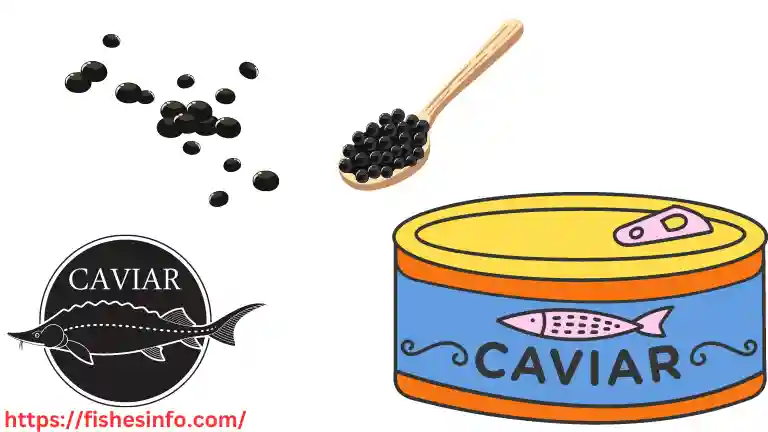
List of Popular Types of Caviar
Here is a list of popular types of caviar:
- Beluga caviar
- Osetra caviar
- Sevruga caviar
- Sterlet caviar
- Kaluga caviar
- Siberian caviar
- Hackleback caviar
- White sturgeon caviar
- Bowfin caviar
These types of caviar are harvested from different species of sturgeon and other fish, and they are prized for their delicate flavor and luxurious texture.
Seaweed
Seaweed is a type of algae that is often eaten in Asian dishes. It is rich in vitamins, minerals, and antioxidants, making it a healthy addition to the diet.
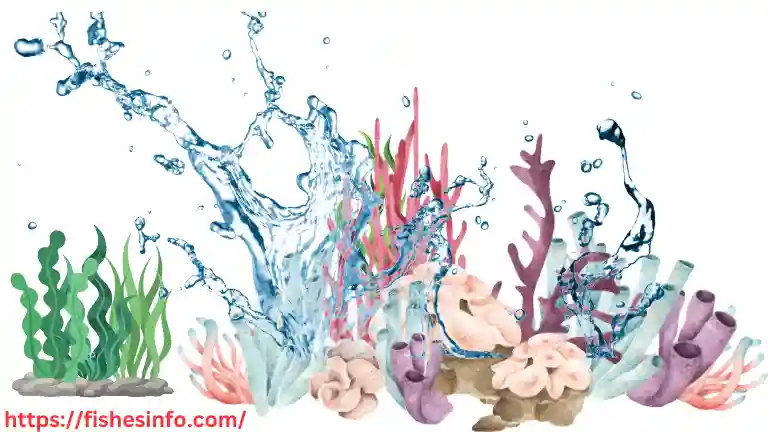
List of Popular Seaweeds
Here is a list of popular types of seaweed used as seafood:
- Nori
- Wakame
- Kombu
- Hijiki
- Dulse
- Arame
- Sea lettuce
- Irish moss
- Spirulina
These types of seaweed are commonly used in various cuisines, particularly in Asian cooking, and they are valued for their unique flavors, textures, and nutritional benefits.
Microphytes
Microphytes, a type of algae, are tiny organisms found in both saltwater and freshwater environments. They live as single cells or chains, often measuring just a few micrometers in diameter, and lack roots or leaves. Adapted to grow in highly slippery conditions, they play a vital part in marine ecosystems.
These algae serve as a crucial food source for various fish and watery animals, offering both sustenance and shelter to small crabs while protecting them from predators. Beyond their biological significance, microphytes also hold importance for human health and the environment, making fish rich in these organisms a healthy choice for eating.
Famous Microphytes used as Seafood
Microphytes, or microalgae, are used as food and vitamins due to their high nutritional value.
Here is a list of some microphytes used in food:
Spirulina
A blue-green algae rich in protein, vitamins, and minerals, often eaten as a food supplement or added to drinks and snacks.
Chlorella
A green plant known for its cleansing qualities and high protein content, available in pill form or as an ingredient in health foods.
Dunaliella salina
A type of green microalga rich in beta-carotene, used as a natural food coloring and nutrition supplement.
Aphanizomenon flos-aquae (AFA)
A type of blue-green algae hailed for its high nutrient content and possible health benefits.
Euglena gracilis
A microalga rich in protein and important amino acids, used in food items and vitamins.
Nannochloropsis
A genus of microalgae used in farming and as a source of omega-3 fatty acids in food and vitamins.
Isochrysis galbana
A marine microalga used as a feed ingredient in aquaculture and as a source of omega-3 fatty acids.
These microphytes are valuable for their nutritional content and possible health benefits. They are used in various forms, including powders, pills, and as ingredients in food items.
Echinoderms
Echinoderms are a group of marine animals that include sea urchins, sea cucumbers, and certain types of starfish. While not as widely eaten as fish or shrimp, some echinoderms are used as foods in certain countries.
Famous Echinoderms used as Seafood
Here is a list of echinoderms used as seafood:
Sea Urchin
The roe (eggs) of sea urchins, known as uni, is considered a treat in many countries and is often used in sushi and sashimi recipes.
Sea Cucumber
Sea cucumbers are used in different Asian recipes, especially in Chinese and Korean foods. They are valued for their spongy feel and are thought to have health benefits.
Certain Species of Starfish
In some countries, especially in parts of Asia, certain species of starfish are eaten as seafood. They are usually made by cooking or drying.
It’s important to note that while these echinoderms are used as seafood in some areas, they are not as widely eaten or as easily available as other types of seafood.
Medusozoa
Medusozoa, popularly known as jellyfish, are not usually eaten as seafood due to their rubbery structure and lack of substantial meat. However, in some Asian recipes, certain species of jellyfish are used in foods for their unique texture and taste.
List of famous Medusozoa Species
Here are a few examples:
Cannonball Jellyfish (Stomolophus meleagris)
Commonly used in Chinese cooking, especially in recipes such as jellyfish salad or as an addition in stir-fries.
Nomura’s Jellyfish (Nemopilema nomurai)
Found in the seas of East Asia, Nomura’s jellyfish are sometimes used in Japanese and Chinese cooking, often stewed and served as a treat.
Moon Jellyfish (Aurelia aurita)
While not widely eaten, moon jellyfish have been used in certain foods in parts of Asia, usually after being treated to remove poisons and improve taste.
It’s important to note that while some countries have cooking traditions that include certain species of jellyfish, they are not a widely eaten or popular seafood choice. Additionally, some kinds of jellyfish can be poisonous and should not be eaten.
Nutrition and Benefits of Seafood
Here is a vertical table outlining the approximate nutritional content of seafood per 100 grams:
| Nutrient | Amount | Benefits |
|---|---|---|
| Protein | 20-25 grams | Essential for growth, repair, and maintenance of body tissues. |
| Omega-3 Fatty Acids | 0.5-2 grams | Support heart health, brain function, and reduce inflammation. |
| Vitamin D | 300-600 IU | Helps maintain bone health and supports immune function. |
| Vitamin B12 | 1-5 mcg | Important for nerve function and red blood cell formation. |
| Selenium | 30-70 mcg | Acts as an antioxidant and supports thyroid function. |
| Iron | 0.5-2 mg | Essential for red blood cell formation and oxygen transport. |
| Zinc | 0.5-2 mg | Supports immune function, wound healing, and DNA synthesis. |
| Iodine | 50-100 mcg | Important for thyroid function and metabolism regulation. |
| Magnesium | 20-50 mg | Supports muscle and nerve function, bone health, and metabolism. |
| Potassium | 200-500 mg | Helps regulate fluid balance, muscle contractions, and nerve signals. |
Please note that these values can vary based on the specific type of seafood and how it is prepared.
Health Hazards of Seafood
While fish offers numerous health benefits, there are also possible dangers linked with its consumption.
Some of the main health risks of fish include:
Mercury Contamination
Certain types of seafood, especially big dangerous fish like shark, swordfish, king mackerel, and tilefish, may contain high amounts of mercury. Mercury can build in fish through the food chain and may pose health risks, especially for pregnant women, nursing moms, and young children.
Foodborne Illness
Seafood, like any fragile food, can be tainted with bacteria, viruses, or parasites that can cause foodborne illnesses such as salmonella, norovirus, Vibrio, and hepatitis A. Proper handling, storage, and cooking of fish are important to reduce the risk of foodborne sickness.
Allergic Reactions
Some people may be allergic to certain types of seafood, such as shellfish (e.g., shrimp, crab, lobster) or finfish (e.g., salmon, tuna, cod). Allergic responses to seafood can range from mild to serious and may include signs such as hives, swelling, trouble breathing, and anaphylaxis.
Biotoxin Contamination
Certain types of seafood, especially shellfish like mussels, clams, and oysters, can collect biotoxins made by algae during dangerous algal blooms. Consumption of contaminated shellfish can cause illnesses such as paralytic shellfish poisoning (PSP), amnesic shellfish poisoning (ASP), and diarrhetic shellfish poisoning (DSP).
Environmental pollutants
Seafood may also be subjected to environmental pollutants such as polychlorinated biphenyls (PCBs), dioxins, and heavy metals from dirty seas. Long-term exposure to these toxins through fish consumption may have adverse health effects.
To lessen the health risks associated with seafood consumption, it’s important to choose seafood that is bought from reliable sources and gathered from clean and safe areas. Additionally, correct keeping, handling, and cooking of fish can help reduce the risk of foodborne sickness and exposure. If you have worries about the safety of fish or specific dietary limits, it’s recommended to speak with a healthcare worker or chef for personalized advice.
Frequently Asked Questions (FAQ)
Are Seafood Boils Healthy?
Seafood boils can be a tasty and filling meal, but their safety depends on how they’re cooked. They usually include a mix of fish like shrimp, crab, and clams, which are rich in protein, omega-3 fatty acids, vitamins, and minerals. However, the addition of high-fat ingredients like sausage, butter, and starchy veggies can increase the calorie and fat content. To make a crab boil healthy, opt for lighter spices, less butter, and include plenty of veggies. Boiling is a low-fat cooking method, but amount control is important as fish boils are often offered in big quantities. Balancing the meal with veggies and whole grains can help make it more healthy. Individuals with specific dietary needs or health issues should tailor their seafood boil to meet their nutritional requirements, picking healthier seafood choices and lowering added fats and salt as required. Overall, with mindful ingredient choices and amount control, seafood boils can be a delicious and healthy meal option.
Are Seafood Boils Gluten Free?
Seafood soups can be made gluten-free with the right items and cooking methods. The biggest worry for gluten-free people is the sauce and any extra foods that may contain gluten. Traditional seafood boil seasonings often include spices and seasonings that are naturally gluten-free, such as salt, pepper, garlic, and onion powder. However, some commercial spice mixes or pre-packaged seasonings may contain gluten-containing products like wheat flour or malt vinegar.
To ensure that a fish boil is gluten-free, it’s important to use gluten-free spices and ingredients. This includes checking labels for any possible sources of gluten and using gluten-free options when necessary. Additionally, it’s important to avoid cross-contamination with gluten-containing foods or cooking tools to prevent gluten exposure.
With careful item selection and preparation, seafood soups can be a delicious and safe choice for those following a gluten-free diet.
Are Seafood Sticks good for You?
Seafood sticks, also known as fake crab sticks or seafood sticks, are a processed seafood product made from surimi, which is a paste made from white fish such as pollock or hake. While crab sticks can be a handy and cheap seafood choice, their nutritional value changes based on the specific brand and products used.
Generally, seafood sticks are lower in calories and fat compared to regular crab meat. They are also a good source of protein, giving about 6-7 grams of protein per stick. However, fish sticks are often highly processed and may contain chemicals, preservatives, and fake colors and tastes.
One possible downside of fish sticks is their high salt level. They can be quite high in salt, especially if they are flavored or seasoned. Excessive salt intake is linked to high blood pressure and other health issues, so it’s important to eat fish sticks in moderation and choose low-sodium options when possible.
Overall, while seafood sticks can be a handy and tasty seafood choice, they should be eaten in moderation as part of a healthy diet. It’s also important to read labels carefully and choose names that use high-quality products and minimal chemicals.
Can Seafood Make you Sick?
Seafood can possibly cause sickness if not handled, kept, or made properly. One common risk is foodborne sickness, which can result from contact with bacteria, viruses, or parasites. Pathogens such as Salmonella, Vibrio, Norovirus, and Hepatitis A can be found in fish and cause sickness if eaten. Another risk is biotoxin poisoning, especially in shellfish like mussels, clams, and oysters. These shellfish can acquire biotoxins made by algae during dangerous algal blooms, leading to sicknesses such as paralytic shellfish poisoning (PSP), amnesic shellfish poisoning (ASP), and diarrhetic shellfish poisoning (DSP).
Additionally, certain types of seafood, especially big predatory fish, may contain high amounts of mercury, which can be dangerous if eaten in large numbers. To minimize the risk of illness from seafood, it’s important to purchase seafood from reputable sources, ensure proper storage and refrigeration, cook seafood to the recommended internal temperature, and avoid consuming raw or undercooked seafood, especially for high-risk groups such as pregnant women, nursing mothers, and young children. Following these tips can help you enjoy fish safely and lower the risk of foodborne sickness.
Can Seafood Cause Gout?
Seafood can possibly add to gout, a form of arthritis caused by high amounts of uric acid in the blood. Some types of fish, such as anchovies, sardines, herring, mackerel, and scallops, are high in purines, which are natural chemicals that break down into uric acid in the body.
Consuming foods high in purines can lead to a rise in uric acid levels, which can cause gout attacks in susceptible people. However, not all seafood is high in purines, and modest usage of low-purine seafood like salmon, trout, and tuna is usually considered safe for most people with gout.
Individuals with gout or at risk of getting gout should speak with their healthcare provider or a certified dietitian to decide the best food method for controlling their disease. This may include limiting high-purine foods, including certain types of fish, and keeping a healthy and balanced diet generally.
What Seafood is High in Mercury?
Several types of seafood are known to contain higher levels of mercury, particularly large predatory fish that are higher up in the food chain. Here are some examples of seafood that tend to be higher in mercury:
Shark
Swordfish
King mackerel
Tilefish (from the Gulf of Mexico)
Marlin
Orange roughy
Bigeye tuna
Gulf tilefish
Chilean sea bass (also known as Patagonian toothfish)
Bluefish
These fish generally live longer and acquire more mercury over time. While modest consumption of seafood is usually considered safe for most people, it’s suggested to limit intake of these high-mercury fish, especially for pregnant women, nursing moms, and young children, who are more sensitive to the effects of mercury. Instead, they can choose lower-mercury choices like salmon, shrimp, and pollock for their fish diet.
What seafood is High in Iron?
Seafood can be a good source of iron, although the amount can change based on the type of seafood. Here are some fish choices that are relatively high in iron:
Clams:
Clams are one of the best sources of iron among fish, with canned clams giving about 23 mg of iron per 100 grams.
Oysters:
Oysters are also rich in iron, with cooked oysters giving about 6.2 mg of iron per 100 grams.
Octopus:
Octopus is a good source of iron, with cooked octopus giving about 2.2 mg of iron per 100 grams.
Squid:
Squid is another fish choice that is relatively high in iron, with cooked squid offering about 2.2 mg of iron per 100 grams.
Mussels:
Mussels are a good source of iron, with cooked mussels giving about 6.7 mg of iron per 100 grams.
Canned Tuna:
Canned tuna is a handy and relatively high source of iron, with canned light tuna offering about 1.4 mg of iron per 100 grams.
Including these iron-rich seafood options in your diet can help you meet your daily iron needs.
Can We eat Seafood during Pregnancy?
Seafood can be a healthy part of a balanced diet during pregnancy, giving important nutrients like protein, omega-3 fatty acids, and vitamins and minerals such as vitamin D, iron, and zinc. Omega-3 fatty acids, found in fatty fish like salmon, trout, and sardines, are especially important for developing brain and eye development. However, pregnant women need to be careful about certain types of seafood that may contain high amounts of mercury, such as shark, swordfish, king mackerel, and tilefish. High mercury amounts can harm the growing nerve system of the baby. It’s recommended for pregnant women to choose low-mercury fish choices like shrimp, salmon, pollock, and canned light tuna. Additionally, pregnant women should avoid raw or uncooked fish, including sushi, sashimi, and mussels, to reduce the risk of foodborne sicknesses. Overall, adding a range of safe and healthy fish into a well-balanced diet can be helpful for both mother and baby health during pregnancy.
Conclusion
Seafood is not just a delicious cooking choice but also a highly healthy one, offering a wealth of health benefits. Rich in omega-3 fatty acids, high-quality protein, vitamins, and minerals, fish supports heart health, brain function, and general well-being.
Its flexibility in cooking makes it a favorite among many flavors worldwide. Whether you’re looking to boost your omega-3 intake or simply enjoy a delicious meal, seafood is a fantastic addition to any diet.
